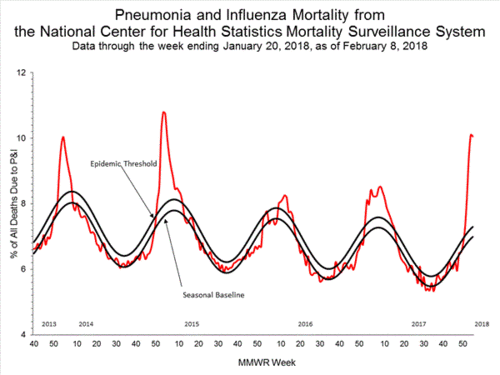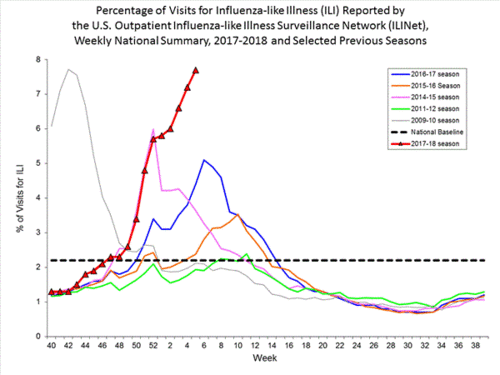2018's flu season surpasses 2009's Swine Flu pandemic, and other takeaways from the latest CDC Flu Report
 The weekly CDC flu report has been released, and it is full of important information. There were several things that jumped out at me, and I wanted to bring them to your attention.
The weekly CDC flu report has been released, and it is full of important information. There were several things that jumped out at me, and I wanted to bring them to your attention.
First: Flu remains everywhere. Oregon seems to have a dip in cases, but I question that. However, 48 other states are positively bathed in flu. It has not abated one whit.
 Second, and the CDC has just admitted this: This year's flu epidemic, in terms of hospital visits, has just surpassed 2009's H1N1 swine flu pandemic. Think of that! A non-pandemic strain of flu has sent more Americans to the hospital than the first pandemic in almost fifty years. While of course I am hopeful pediatric deaths will not reach the level seen in 2009, we are seeing pediatric and young adult sickness and death at a rate seldom seen in a flu season.
Second, and the CDC has just admitted this: This year's flu epidemic, in terms of hospital visits, has just surpassed 2009's H1N1 swine flu pandemic. Think of that! A non-pandemic strain of flu has sent more Americans to the hospital than the first pandemic in almost fifty years. While of course I am hopeful pediatric deaths will not reach the level seen in 2009, we are seeing pediatric and young adult sickness and death at a rate seldom seen in a flu season.
Third: Flu season is a marathon, not a sprint. And while the cumulative ratios of A/H3N2 to B has been roughly 80/20 this season, we are seeing a surge in cases of Influenza B. This is nothing to celebrate: As you recall, the young 12-year old boy from West Palm who died, was typed using reverse PCR as having had Influenza B.
Fourth: The strain of B that is the strongest -- the Yamagata strain -- is antigenically very similar to what is in the current flu shot! So despite what you have heard, or read, about this year's weenie performance of the shot, it is still a very, very good idea to have one. Because the B protection is significant, and since B's jockey is showing the horse the whip, it might just continue to gain market share. How many metaphors can I mix here?
Fifth, and this one is a biggie: Laboratory-confirmed influenza-related hospitalizations of persons aged 65 years or older are Off. The. Charts. This acceleration began around Christmas and has not abated one bit. Second place: Persons 50-64. Their ascent is not as dramatic but it is significant.
Sixth: Deaths from flu this season are substantially higher than the epidemic threshold. Ten percent of all the deaths in this country were from flu and accompanying pneumonia. The normal epidemic threshhold is just above seven. And because of regional lags in inputting death records, the final figure will be worse.
Seventh: It's amazing what changes happen when you haven't been paying attention. Loyal readers of this blog will instantly recognize the name BioCryst, the pharma company once HQ'ed in Birmingham, Alabama, and which relocated to the Research Triangle of North Carolina. I came across a chart showing antiviral resistance, and listed were three antivirals: Oseltamivir (Tamiflu), zanamivir (Relenza), and -- peramavir! Peramivir is the injectable antiviral created by BioCryst! Apparently they were granted FDA approval back in 2014. I had stopped blogging by then, so it was nice to see that another antiviral had been added to the mix -- and that I was right to keep track of BioCryst.
The complete report is available here. This flu epidemic continues to confound and frustrate.

Reader Comments